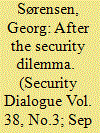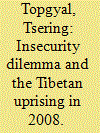| Srl | Item |
| 1 |
ID:
078777


|
|
|
|
|
| Publication |
2007.
|
| Summary/Abstract |
The security dilemma - which raises the imminent risk of war between sovereign states - has always been considered the core issue of international relations. But, the security dilemma is in decline. Interstate war is no longer the supreme concern on the international security agenda. Instead, new dilemmas have emerged, in particular the insecurity dilemma and the associated value dilemma. The insecurity dilemma poses a looming risk of violent domestic conflict in weak states. The related value dilemma concerns the ambiguous content of core liberal values. Negative liberty is autonomy, self-determination and the ability to act unimpeded by others. The promotion of negative liberty calls for non-intervention. Positive liberty is removal of the obstacles that stand in liberty's way: oppression, poverty, ignorance and tyranny. The promotion of positive liberty calls for intervention. Emphasizing negative liberty creates grave problems; emphasizing positive liberty creates grave problems of a different kind. Compromises between intervention and non-intervention must always be troubled and uneasy, because they involve trade-offs between liberal values that are all desirable. There is no clear path to a more liberal world order
|
|
|
|
|
|
|
|
|
|
|
|
|
|
|
|
| 2 |
ID:
101926


|
|
|
|
|
| Publication |
2011.
|
| Summary/Abstract |
In March 2008, Tibet erupted in the biggest challenge to Chinese rule since 1959. While Beijing and Dharamsala engaged in their familiar battle of representations, pundits speculated on the causes of the uprising, ranging from conspiracy theories to informed policy analysis. Applying the framework of the insecurity dilemma, this article argues that Tibetan identity insecurity on account of the post-1989 hard-line Chinese policies was the chief cause of the uprising. Largely peaceful protests and occasionally violent riots in Tibet have been integral to Tibetan efforts to mitigate their societal insecurities provoked by Chinese migration, 'assimilationist' policies and 'cultural imperialism'. However, Tibetan protests and riots heighten Chinese insecurities and harden Beijing's policies both inside Tibet and towards the Dalai Lama. This paper reveals the dynamic cycle of hard-line Chinese policies provoking Tibetan uprisings; the resulting hardening in Chinese policies feeds back into Tibetan insecurities and protests. The 2008 uprising was the most recent cycle in the long-running saga of the Sino-Tibetan insecurity dilemma. The article warns that unless the Tibetans and the Chinese find a way to break out of the insecurity dilemma, Tibet could explode into another frenzy of violence and counter-violence in the near future.
|
|
|
|
|
|
|
|
|
|
|
|
|
|
|
|